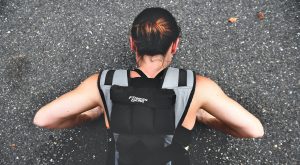If you want to enhance your explosive power, strength and speed, you may want to give weighted vest training a go. The weighted vest was originally used by special forces operatives for extended periods as a part of their training.
Today, weighted vest training is used in many fitness disciplines to effectively lose weight and further increase power. If you want to learn more about weighted vests, its proper use, and safety guidelines to maximise the results, continue reading.
How does a weighted vest work?
A weighted vest with more than 12-lb (approx. 5.44 kg) of weight can help you burn between 200 and 300 calories. It is a compact and wearable fitness equipment that you can bring with you anywhere, so you can optimise your workouts or add challenge to an existing fitness regimen.
Weighted vests come in various weights. As an individual progresses, the weight increases resulting in speed and power increase.
But before you put in a weighted vest, it’s imperative to learn about its proper use to ensure results and avoid injuries or accidents.
10 Weighted Vest Mistakes
1. Forgetting the 10% Rule
Choose the weight of the vest carefully. At most, your chosen weighted vest should not exceed more than 10% of your total body weight. For instance, a 150-lb (approx. 68 kg) individual can safely workout wearing a 15-lb (approx. 6.8 kg) vest.
You may purchase a weighted vest with adjustable weights, so you can train with variable weights that allows you more flexibility when performing various exercises.
2. Training Carelessly
While slowing down during a speed training regimen, an individual is more likely to face a greater risk of injury. The external loading of a weighted vest may put you in danger while shifting to movements such as bending the knees or lowering the body.
3. Speed is Not Your Goal
The goal of wearing a weighted vest is to improve on your speed. Endurance is an extra benefit that users develop in the long run. Unlike traditional speed training implements, a weighted weight is the only tool that encourages and promotes proper form.
When you are wearing a vest, the fatigue rate of muscle groups increases. To make the most out of your speed training, do three to five reps of 18.28-metre sprints while wearing a weighted vest.
4. Disregarding Vest-to-Rest Ratio
Before trying out a weighted vest training, remember the recommended vest-to-rest ratio. For free sprints, the vest-to-rest ratio is set at 10:60, which means 60 seconds of rest for every 9.14-metre sprint. If you are performing speed training, the ratio changes to 10:80 or 80 seconds of full rest for every 9.14-metre sprint.
5. Not Removing the Weighted Vest After Training
Experts recommend taking off the weighted vest immediately after speed sessions. In this way, you can activate the speed muscles in an explosive manner.
6. Wearing a Weighted Vest All Day Long
No matter your fitness level, it is not recommended to don a weighted vest the entire day as this can do more harm than good to your health and overall wellness.
Prolonged periods of wearing a weighted vest can result in shoulder pain, added pressure to the spine, and poor posture. The use of weighted vest during speed training is only beneficial when worn for a few hours a day, not an entire day.
Do not force yourself to wear it for an extended period as this may lead to chronic back pain or irreversible damage to your body. Overuse of the vest may also result in shoulder stiffness that can compromise other aspects of your strength and conditioning.
7. Choosing the Wrong Vest
Choose a weighted vest that corresponds to your specific training. There are endurance weighted vests and there are vests that for CrossFit and Calisthenics athletes that are heavier than endurance vests.
8. Going Heavy At the Onset
This safety precaution is applicable to endurance athletes given the period under tension is greater during trainings. Always start light and only add when you’ve progressed in terms of power, speed, and endurance. The last thing you want is sustain an injury at the onset of your weighted vest training.
9. Planning Trainings without Strategy
Weighted vests place great pressure and weight on your feet, which means you need to wear the right type of shoes. Ideally, you should use high-quality footwear with sufficient arch support and padding. Additionally, it is recommended that you take breaks in between weighted vest training.
Do not forget to perform stretching before and after training, foot massages, and soak your feet in warm water. These are just some effective means of relaxing your feed from the arduous speed and endurance trainings with a weighted vest on.
10. Wear It Right Away
Weighted vest training isn’t for all athletes. If you feel discomfort or pain while wearing it, listen to your body. Do not force yourself into wearing it for the sake of keeping up with fellow athletes.
